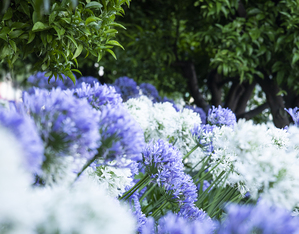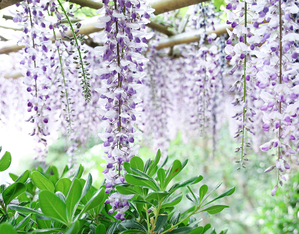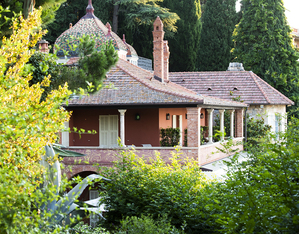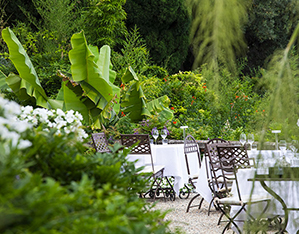In the late 19th century, this part of the coast was popular with an English community that sought escape from the strictures of Victorian life. The Gardens at Villa della Pergola explode in intense Mediterranean colours, themed plants and valuable collections spread over terraces.
Built in the late 19th century and overlooking the sea, the Gardens of Villa della Pergola are a rare example of an Anglo-Mediterranean park whose entire 22,000 m original extension has survived to the present day. Visitors may today admire the harmony of its Mediterranean vegetation, many rare plants and evocative, exotic flora. In 1875, General William McMurdo purchased the first part of the property, which had previously belonged to the Counts of Lengueglia. After restoring the small building already on site, McMurdo commissioned Domenico Gorlero to design a large and eclectic Villa, with loggias and bay windows opening onto gardens conceived as a continuation of the residence. Olive trees, citrus and carob trees were added to the Gardens’ pre-existing palms, cypresses and decor including giant antique jars, spread across a number of terraces supported by dry stone walls and embellished with numerous outlooks over the sea and mountains. The General was involved in the design; the chief gardener, however, was his wife Susan Sarah Napier, who had long resided in the East. In 1903, the property was acquired by Sir Walter Hamilton Dalrymple who, according to writer William Scott, made it “a worthy rival to the Mortola Gardens”, adding new plants that included many climbing roses, creating a ruined “folly”, and opening the Gardens to the public. In 1922, Daniel Hanbury, son of Thomas (who had created the Gardens at Mortola), acquired the gardens, enriching them with cacti, cycads and eucalyptus trees. After falling into a long period of decline and neglect, in 2006 the Gardens were saved from a speculative building project and underwent meticulous restoration under the watchful eye of Paolo Pejrone, with the onus on salvage and conservation. Working with Silvia Arnaud Ricci, Peirone has established esteemed botanical collections of wisteria and agapanthus, as certified by the Italian Society for Horticultural Science (SOI).
Highlights

Agapanthus Collection
Native to southern Africa, the original English owners brought Agapanthus plants to Villa della Pergola in the late 1800s. When architect Paolo Pejrone salvaged the park, large numbers of new specimens were planted to create Europe’s largest collection, numbering some 500 varieties. In late June, they paint the Gardens intense shades of blue, azure and white, colours that mimic sea waves.

Pergolas
The Villa’s name references its numerous wooden arbors, or topie, that since General McMurdo’s day link the park’s various levels. They are festooned with climbing roses – especially banksiae – and bougainvillea. Since being restored and extended, they offer Italy’s single most significant collection of wisteria, spanning some 34 varieties. Between March and late April, they bloom in long, drooping clusters in a variety of colours – a sight not to be missed.

Small Museum
The Villa contains a small museum of historic memorabilia, chronicling English aristocratic families and personages from around the world who have sojourned at Villa della Pergola over the years. The Villa has inspired artists Carlo Levi and Henry Scott Tuke, Pulitzer Prize winner Richard Howard, and Directors including Oscar-winners Guy Green and Alfred Hitchcock, who shot some scenes of his first film “The Pleasure Garden” in Alassio.

Michelin-Starred Restaurant
Ah, the delights of dining with a sea view, drinking in the scent of wisteria and the garden’s lush vegetation... Michelin-starred Restaurant Nove is a perfect combination of Chef Giorgio Servetto’s skills and the delights of Villa della Pergola, combining high-quality, strictly local raw materials, and seasonal produce, applying his experimental touch of modernity to local culinary tradition.
 Giardini di Villa della Pergola
Contacts
Giardini di Villa della Pergola
Contacts
 Giardini di Villa della Pergola
Opening times and prices
Giardini di Villa della Pergola
Opening times and prices
Opening hours
Entrance only with guided tours by appointment.
Pricing
Single € 12,00
FAI members (by showing the valid membership card) € 10,00
Children up to 6 years (accompanied by a paying adult) free admission
Kids from 6 to 14 years € 6,00
Reservation is required to visit the gardens.
 Giardini di Villa della Pergola
How to get there
Giardini di Villa della Pergola
How to get there
Address
Via Privata Montagu, 9
17021 , Alassio (SV)
Latitude: 44.010933
Longitude: 8.172741
How to arrive by road
Motorway A10 Genova – Ventimiglia
From Genoa: exit Albenga, take the Aurelia Bis (S.S.1 bis) or the Via Aurelia towards Alassio (10 min.)
From Ventimiglia: exit Andora, take the Via Aurelia, (S.S. 1) towards Alassio (10 min.)
 Giardini di Villa della Pergola
Services/Accessibility
Giardini di Villa della Pergola
Services/Accessibility
Services
The Restaurant Nove, inside Villa della Pergola, is open from 12.30 am to 2.00 pm and from 7.30 pm to 10.00 pm. Closed on Tuesdays (except August). For information and reservations +39 0182 646140 or [email protected]
Educational workshops for children are planned, at a cost of € 8.00 (including visit). For information and reservations +39 0182 646130 or [email protected]
Pets of any size are not allowed in the Gardens.
The gardens do not have visitor parking. For the disabled or special needs please contact the structure at +39 0182 646130 or e-mail.
Relais
Hospitality at Villa della Pergola, Relais & Chateaux For information and reservations: [email protected]
Accessibility
Most of the gardens can also be visited by disabled people. Only a few small areas are not accessible due to the morphology of the terrain and the presence of small stone stairs.
 Giardini di Villa della Pergola
Private events
Giardini di Villa della Pergola
Private events
 Giardini di Villa della Pergola
Itineraries
Giardini di Villa della Pergola
Itineraries
You could find the garden in these itineraries
 Favorite saving result
Favorite saving result
 Warning!
Warning!
You've have to sign up or sign in to add this element to your favorites.
